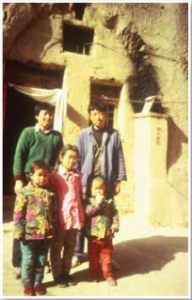Your Fireplace Could be Hurting Your Health
JUST LIKE A CAVE-DWELLER’S COOKING FIRE!
Even though Roman Emperor Justinian I declared that clean air was a birthright way back in 535 A.D., for many people it remains a privilege. As I said on Pg. 1, not every society in the world has progressed to the point we’ve reached in the U.S., where we have indoor air quality standards, experts, and solutions. Some people are still stuck in the past — dealing with the indoor air quality issues we had 5,000 years ago.
In Africa, many native tribes still use animal waste for fuel and cook their food in tents or huts. These huts have small openings at the very top for smoke to dissipate, but even with these basic chimneys, the tribespeople are exposed to high levels of fine particulate matter.
Those folks generate and breathe in scary amounts of pollution, and it causes long-term health problems. The effects can be as simple as a runny nose or as terrifying as respiratory cancer.
 In China, locals face similar problems. I’ll never forget when I first learned about them. Roughly 20 years ago, one of my peers sent me a photo of a cave city in Southwest China. As difficult as it is to believe, more than 30 million people still live in caves in that area.
In China, locals face similar problems. I’ll never forget when I first learned about them. Roughly 20 years ago, one of my peers sent me a photo of a cave city in Southwest China. As difficult as it is to believe, more than 30 million people still live in caves in that area.
These caves are stacked side by side and one on top of the other, like a condominium built directly into the rock. The photo my colleague sent showed a family of four standing proudly in the mouth of their cave. It had a curved opening decorated with a door. Near the door was an exhaust vent for the stove located right inside the entryway.
At first glance, this might seem like a pretty good setup for indoor air quality. When the family uses the stove to cook or heat their home, the smoke travels out of the vent and is exhausted outside. Unfortunately, this design only works well for the families living on the bottom level of these cave condominiums. Their smoke travels upward and fresh air is pulled inside. But the families above them aren’t pulling in fresh air — they’re bringing in smoke from their downstairs neighbors.
This means the air quality in the caves becomes worse the higher you go in the condo. Folks at the top get the highest level of exposure to the smoke of the other tenants, and they have to breathe in particulate matter from their own fires. It’s a disastrous situation for their health, and it’s happening to 30 million people every day.
These problems may sound far away, but even you could be plagued by similar health issues if you have a fireplace in your home. Just like the cooking stoves of those families in China, woodburning fireplaces give off particles that can be dangerous to your health.
My wife, Kaye, and I have a fireplace in our house, and about 20 years ago we had a problem with smoke odors and contaminants wafting out into our living area. We ultimately decided to replace the wood with a gas log. If you’re attached to your wood fireplace, be sure to keep the firebox clean, hire a chimney sweep to clean your flue, and consider putting glass doors on the fireplace to manage back drafting. All three of those steps will protect your health — and keep you safe from a house fire.
We’ve come a long way on indoor air quality over the last 5,000 years, but there’s still work to be done, especially for low-income families across the world.

